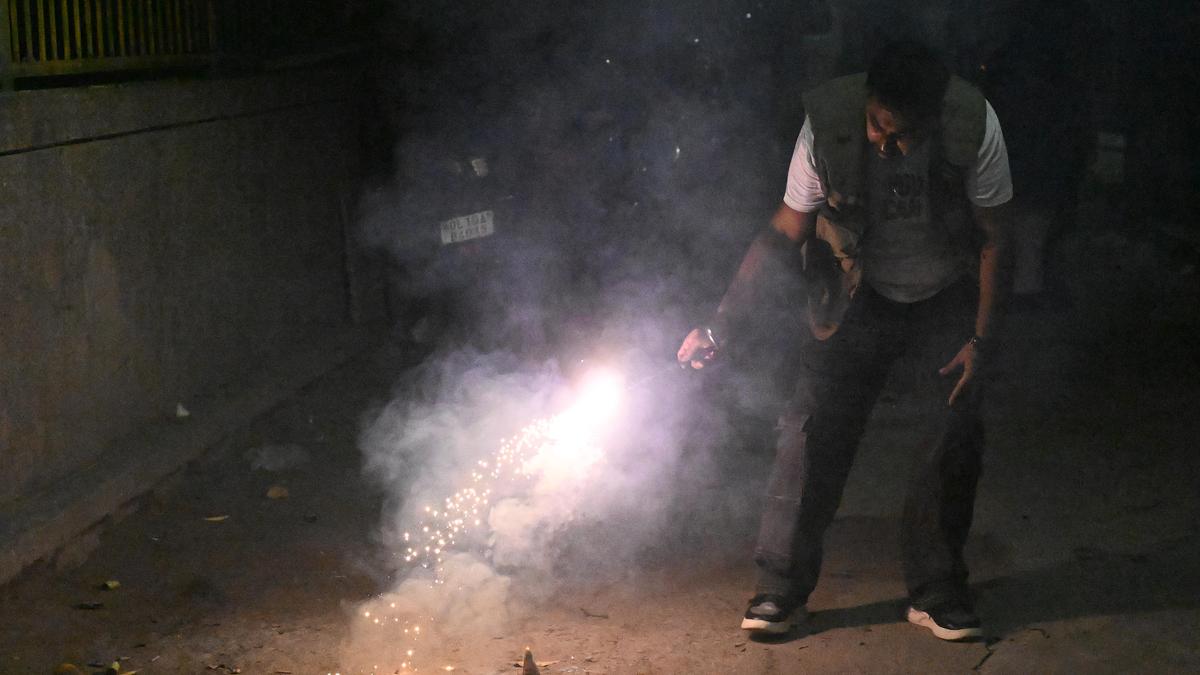
Delhiites seen Celebrating Deepavali, in New Delhi
| Photo Credit: Sushil Kumar Verma
As Delhiites burst firecrackers well past the 10 p.m. deadline set by the Supreme Court for Deepavali night, air pollution shot up to 100 times World Health Organisation (WHO) limits, but fell quickly, shows official data.
The relatively quicker fall was due to higher wind speed and temperature, according to experts.
Meanwhile, the Delhi Pollution Control Committee (DPCC) data on air pollution for the intervening night between Monday and Tuesday had several missing data points. This led to activists questioning the authenticity of the data.
Hourly data of PM2.5 (a chief pollutant) for many of the stations were missing when the pollution was at its peak last night between 11 p.m. and 3 a.m., as per DPCC’s website.
“PM2.5 crossed 1,000 µg/m³ in Delhi last night, yet official air pollution data went missing at peak hours. If we lose data on the worst nights, how can CPCB ensure accurate pollution reporting?” said Bhavreen Kandhari, an environmental activist.
The level of PM2.5 in Nehru Vihar was 1,753 micrograms per cubic meter at 10 p.m. on Monday, as per DPCC data — This is about 116.8 times the WHO permissible limit of 15 micrograms per cubic meter for a 24-hour period. But after that data is missing for several hours.
The level of the pollutant at Patparganj was 1,144.8 micrograms per cubic meter at 4 a.m. on Tuesday, which is over 76 times the WHO limit. But several data points before that are missing, the official data shows.
Similarly, the level of the pollutant at Ashok Vihar was 1,353 micrograms per cubic meter at 12 a.m. on Tuesday, which is over 90 times the WHO limit. But here also several data points before and after being missing.
“The pollution peaked between 12-4 am and fell quickly due to high wind speed and high ventilation. As the Deepavali is earlier than usual, temperatures have not dropped drastically and wind speed is also higher,” said a scientist at the Indian Institute of Tropical Meteorology, Pune. “The wind speed was around 5-10 km/hr around midnight and this was more than what was predicted. This flushed out the pollutants immediately.”
Gufran Beig, chair professor, National Institute of Advanced Studies, said that wind speed being “moderately high” helped to clear the pollutant. “There was disbursement of pollutants from around 4 am and from 9 am there was rapid improvement,” he said.
About missing data, Mr. Beig, who is also the founder-director of central government’s SAFAR (System of Air Quality and Weather Forecasting Research), said that a plausible explanation is that the actual pollution level was beyond the scale of measurement.
“The missing data has led to underestimation of AQI. So, that actual AQI will be more than what the CPCB is reporting,” Mr. Beig said.
Published – October 22, 2025 03:50 am IST

